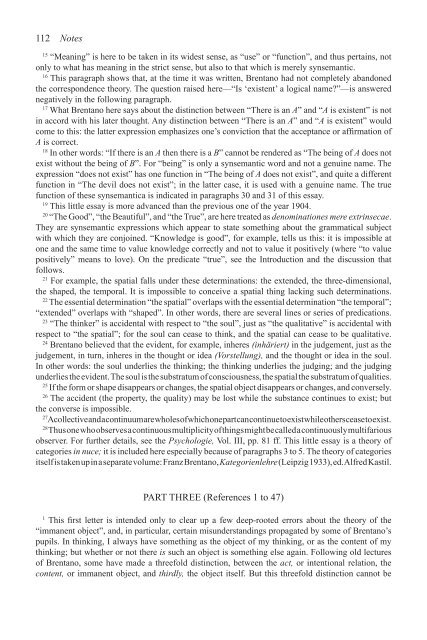Franz Brentano_The True and the Evident.pdf
Franz Brentano_The True and the Evident.pdf
Franz Brentano_The True and the Evident.pdf
You also want an ePaper? Increase the reach of your titles
YUMPU automatically turns print PDFs into web optimized ePapers that Google loves.
112 Notes<br />
15 “Meaning” is here to be taken in its widest sense, as “use” or “function”, <strong>and</strong> thus pertains, not<br />
only to what has meaning in <strong>the</strong> strict sense, but also to that which is merely synsemantic.<br />
16 This paragraph shows that, at <strong>the</strong> time it was written, <strong>Brentano</strong> had not completely ab<strong>and</strong>oned<br />
<strong>the</strong> correspondence <strong>the</strong>ory. <strong>The</strong> question raised here—“Is ‘existent’ a logical name?”—is answered<br />
negatively in <strong>the</strong> following paragraph.<br />
17 What <strong>Brentano</strong> here says about <strong>the</strong> distinction between “<strong>The</strong>re is an A” <strong>and</strong> “A is existent” is not<br />
in accord with his later thought. Any distinction between “<strong>The</strong>re is an A” <strong>and</strong> “A is existent” would<br />
come to this: <strong>the</strong> latter expression emphasizes one’s conviction that <strong>the</strong> acceptance or affirmation of<br />
A is correct.<br />
18 In o<strong>the</strong>r words: “If <strong>the</strong>re is an A <strong>the</strong>n <strong>the</strong>re is a B” cannot be rendered as “<strong>The</strong> being of A does not<br />
exist without <strong>the</strong> being of B”. For “being” is only a synsemantic word <strong>and</strong> not a genuine name. <strong>The</strong><br />
expression “does not exist” has one function in “<strong>The</strong> being of A does not exist”, <strong>and</strong> quite a different<br />
function in “<strong>The</strong> devil does not exist”; in <strong>the</strong> latter case, it is used with a genuine name. <strong>The</strong> true<br />
function of <strong>the</strong>se synsemantica is indicated in paragraphs 30 <strong>and</strong> 31 of this essay.<br />
19 This little essay is more advanced than <strong>the</strong> previous one of <strong>the</strong> year 1904.<br />
20 “<strong>The</strong> Good”, “<strong>the</strong> Beautiful”, <strong>and</strong> “<strong>the</strong> <strong>True</strong>”, are here treated as denominationes mere extrinsecae.<br />
<strong>The</strong>y are synsemantic expressions which appear to state something about <strong>the</strong> grammatical subject<br />
with which <strong>the</strong>y are conjoined. “Knowledge is good”, for example, tells us this: it is impossible at<br />
one <strong>and</strong> <strong>the</strong> same time to value knowledge correctly <strong>and</strong> not to value it positively (where “to value<br />
positively” means to love). On <strong>the</strong> predicate “true”, see <strong>the</strong> Introduction <strong>and</strong> <strong>the</strong> discussion that<br />
follows.<br />
21 For example, <strong>the</strong> spatial falls under <strong>the</strong>se determinations: <strong>the</strong> extended, <strong>the</strong> three-dimensional,<br />
<strong>the</strong> shaped, <strong>the</strong> temporal. It is impossible to conceive a spatial thing lacking such determinations.<br />
22 <strong>The</strong> essential determination “<strong>the</strong> spatial” overlaps with <strong>the</strong> essential determination “<strong>the</strong> temporal”;<br />
“extended” overlaps with “shaped”. In o<strong>the</strong>r words, <strong>the</strong>re are several lines or series of predications.<br />
23 “<strong>The</strong> thinker” is accidental with respect to “<strong>the</strong> soul”, just as “<strong>the</strong> qualitative” is accidental with<br />
respect to “<strong>the</strong> spatial”; for <strong>the</strong> soul can cease to think, <strong>and</strong> <strong>the</strong> spatial can cease to be qualitative.<br />
24 <strong>Brentano</strong> believed that <strong>the</strong> evident, for example, inheres (inhäriert) in <strong>the</strong> judgement, just as <strong>the</strong><br />
judgement, in turn, inheres in <strong>the</strong> thought or idea (Vorstellung), <strong>and</strong> <strong>the</strong> thought or idea in <strong>the</strong> soul.<br />
In o<strong>the</strong>r words: <strong>the</strong> soul underlies <strong>the</strong> thinking; <strong>the</strong> thinking underlies <strong>the</strong> judging; <strong>and</strong> <strong>the</strong> judging<br />
underlies <strong>the</strong> evident. <strong>The</strong> soul is <strong>the</strong> substratum of consciousness, <strong>the</strong> spatial <strong>the</strong> substratum of qualities.<br />
25 If <strong>the</strong> form or shape disappears or changes, <strong>the</strong> spatial object disappears or changes, <strong>and</strong> conversely.<br />
26 <strong>The</strong> accident (<strong>the</strong> property, <strong>the</strong> quality) may be lost while <strong>the</strong> substance continues to exist; but<br />
<strong>the</strong> converse is impossible.<br />
27 A collective <strong>and</strong> a continuum are wholes of which one part can continue to exist while o<strong>the</strong>rs cease to exist.<br />
28 Thus one who observes a continuous multiplicity of things might be called a continuously multifarious<br />
observer. For fur<strong>the</strong>r details, see <strong>the</strong> Psychologie, Vol. III, pp. 81 ff. This little essay is a <strong>the</strong>ory of<br />
categories in nuce; it is included here especially because of paragraphs 3 to 5. <strong>The</strong> <strong>the</strong>ory of categories<br />
itself is taken up in a separate volume: <strong>Franz</strong> <strong>Brentano</strong>, Kategorienlehre (Leipzig 1933), ed. Alfred Kastil.<br />
PART THREE (References 1 to 47)<br />
1 This first letter is intended only to clear up a few deep-rooted errors about <strong>the</strong> <strong>the</strong>ory of <strong>the</strong><br />
“immanent object”, <strong>and</strong>, in particular, certain misunderst<strong>and</strong>ings propagated by some of <strong>Brentano</strong>’s<br />
pupils. In thinking, I always have something as <strong>the</strong> object of my thinking, or as <strong>the</strong> content of my<br />
thinking; but whe<strong>the</strong>r or not <strong>the</strong>re is such an object is something else again. Following old lectures<br />
of <strong>Brentano</strong>, some have made a threefold distinction, between <strong>the</strong> act, or intentional relation, <strong>the</strong><br />
content, or immanent object, <strong>and</strong> thirdly, <strong>the</strong> object itself. But this threefold distinction cannot be
















